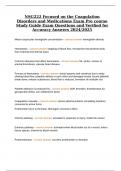NSG222 Focused on the Coagulation
Disorders and Medications Exam Pre course
Study Guide Exam Questions and Verified for
Accuracy Answers 2024/2025
Mean corpuscular hemoglobin concentration - correct answer hemoglobin density
Hemostasis - correct answer stopping of blood flow, mechanism that protects body
from external and internal injury
Common diseases that affect hemostasis - correct answer MI, stroke, venous or
arterial thrombosis, valvular heart disease
Process of hemostasis - correct answer vessel spasms and constricts due to body
slowing blood flow, platelets adhere to each other and damaged vessel, bound platelets
break down, release substances, blood flow is reduced, formation of insoluble clot
Platelet adhesion is produced by - correct answer ADP, thrombin, thromboxane A2,
glycoprotein iib/iiia, von willebrand's factor
Coagulation cascade - correct answer various plasma proteins circulating (inactive)
converted to active forms
Prothrombin turns to thrombin, fibrinogen converts to fibrin
Intrinsic pathway - correct answer activated in response to injury, inside the vessel
Extrinsic pathway - correct answer activated when blood leaks out of a vessel, enters
tissue spaces, external to blood vessels
Prothrombinase - correct answer converts prothrombin to thrombin
, Fibrinolysis - correct answer circulation must eventually be restored, resume normal
function, initiated 24-48 hours, continues until clot dissolves
Process of fibrinolysis - correct answer nearby blood vessel cells secrete tissue
plasminogen activator, converts plasminogen to plasmin, digests fibrin stands, remove
the clot
Arterial thrombi - correct answer deprive area of adequat blood flow, can cause tissue
ischemia, infarction, needs immediate action
Venous thrombi - correct answer common in legs, DVT
Embolus - correct answer traveling clot, most common in lungs (pulmonary embolus
Thrombocytopenia - correct answer too little platelets, decreased platelet production or
increased platelet destruction
Deficiencies in clotting factors - correct answer with serious hepatic impairment,
hemophilia (genetic deficiency, specific clotting factor)
Bleeding precautions - correct answer know what activities or sports to avoid, learn
signs and symptoms of bleeding, no aspirin or nsaids, plan ahead for any
procedures/surgery, regular dental visits, stool softener to avoid straining, avoid rectal
temperatures, antidotes if possible
Activated partial thromboplastin time (aptt) - correct answer monitors heparin; normal
value 25-35 seconds, therapeutic range 60-80 seconds, if high it indicates risk for
bleeding
Prothrombin time (PT) - correct answer monitors warfarin, normal range is 11-14
seconds, therapeutic range 18-24 seconds, high values indicate risk for bleeding




